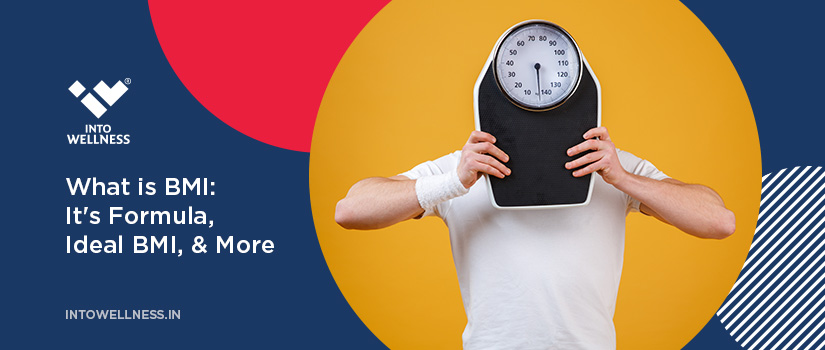No products in the cart.

Body mass index (BMI) is a calculation of an estimated body fat in comparison/proportion with height and weight. An equation is used to make an approximation (and it doesn’t measure the body fat directly). BMI can help determine whether a person is at an unhealthy or healthy weight, which can be thus used as reference to improve upon it.
A high BMI can be a sign of too much fat on the body, and the higher a person’s BMI, the greater their chances of developing certain serious health conditions, such as diabetes, heart diseases, high blood pressure, etc.
On the other hand, a very low BMI can also cause health problems, such as bone density loss, decreased immunity, and anemia.
BMI can be useful in screening body weight in children and adults, but it does have its limitations, as it does not include other factors affecting your body weight.
BMI Formula
BMI is calculated by dividing a person’s weight by the square of their height, here’s a link to an adult BMI calculator for age 20 and above. You try to put in your weight and check your BMI immediately.
BMI is calculated the same way for people of all ages. However, the interpretation of BMI is different for adults and children.
BMI for Adults
Adults age 20 and older can interpret their BMI based on the following standard weight categories, this range is common for both men and women (irrespective of their body types):
- If the BMI is below 18.5 that means you’re underweight.
- Between 18.5 – 24.9 is normal.
- 25.0 – 29.9 indicates that you’re overweight.
- And Obesity is when your BMI is above 30.0.
BMI for Children
BMI implications for children and adolescents can vary depending on age and gender, as the amount of body fat changes with age. Young girls usually acquire a higher amount of body fat and develop it earlier than boys. BMI in children is shown as a percentile ranking, where each percentile expresses a child’s BMI relative to other children of the same age and gender.
Mentioned below is the percentile range for each weight status:
- Below 5th percentile means the child is underweight.
- 5th – 85th percentile indicates normal or healthy weight.
- 85th to 95th percentile shows the child is overweight.
- And percentile above 95 means the child is obese.
BMI and Health
Obesity and overweight is common in people these days, especially because of the sedentary lives (majorly in front of the computer screens) and very less amount of physical activity.
Biologically, people gain weight as a result of an energy imbalance, as the body needs a certain amount of energy from food in order to function and this is obtained in the form of calories. Energy imbalance is one of the biggest reasons for weight gain. If you have a high BMI, it’s important to lower it so you’re at a healthy weight range and to avoid the risk of developing serious health conditions.
How doctors use BMI
BMI is not accurate enough to use as a diagnostic tool, but it can be used to understand the potential weight problems in adults and children.
If someone has a high or low BMI, a doctor or other healthcare professional might consider other important factors too, such as:
- Skinfold thickness measurements- indicating fat in the body of adults and children.
- Evaluations of diet and physical activity.
- Family history of cardiovascular disease and other health problems which can be genetic.
The doctor or healthcare professional then alters and suggests diet and exercise recommendations based on these results.
Health Risks of Extra Weight
We all have heard enough about the disadvantages of excess weight, but listed below are its effects on the body:
- It increases blood pressure, blood cholesterol and triglyceride levels.
- Lowers good cholesterol levels.
- More likely to cause diabetes and other health problems like gallbladder disease, osteoarthritis, respiratory problems, etc.
Carrying extra weight as a child or teenager can also pose significant health risks, during childhood and into adulthood such as asthma, low self-esteem, psychological stress etc.
Risks associated with being underweight
Overweight is certainly unhealthy, but being underweight also has its own associated risks:
- Malnutrition, vitamin deficiencies, anemia.
- Disease that causes bone weakness, increasing the risk of breaking a bone.
- Growth and development issues (in children and teenagers).
- Reproductive issues to hormonal imbalances in women can affect the menstrual cycle.
- Higher chance of miscarriage in the first trimester, because of being underweight.
Consult your doctor if you think you or someone you know is underweight, so treat it and reduce the risk of health problems.
Exercise to Help Control Weight
Regular physical activity is one of the most important things you can do for your weight and health. Everyone can experience the health benefits of physical activity, irrespective of their age, abilities, shape, or size.
To understand the basics of exercising, they can be categorized into two:
Aerobic Exercises
Aerobic exercises in which a person’s muscles move in a rhythmic and coordinated manner for a sustained period of time. They are termed aerobic because they require oxygen to generate energy. Aerobic exercises increase a person’s heart rate and breathing rate to supply more oxygen to the muscles, some of the examples are brisk walking, running, cycling, swimming etc. These exercises can also be called cardio exercises.
Anaerobic Exercises
Anaerobic exercises are those that involve short, intense bursts of physical activity; and they are termed anaerobic because they do not involve an increase in the absorption and transportation of oxygen. During anaerobic exercise, the body breaks down glucose stores in the absence of oxygen, which leads to building of lactic acid in the muscles. These exercises include sprinting, weightlifting and even high intensity interval training (HIIT).
The main differences between both these types of exercises are how the body uses stored energy, the intensity of the exercise and the length of time that a person is able to maintain the exercise.
How does physical activity prevent obesity
Physical activity increases people’s total energy expenditure, which can help them stay in energy balance or even lose weight. At the same time, physical activity paired with diet control can also help (without compensating for the extra calories they burn). Physical activity or exercising decreases fat around the waist and total body fat, slowing the development of abdominal obesity. Weight training such as weight lifting, push-ups, and other muscle-strengthening activities build muscle mass, increasing the energy that the body burns throughout the day-even when it’s at rest, thus making it easier to control weight. Exercising regularly also reduces depression and anxiety, and this also boosts good mood and keeps you motivated to stick with the exercise routine.
The Bottom Line For Weight Control

BMI can be a useful primary screening tool for predicting certain health risks, but you should use it with caution, as it does detect or consider other factors causing the body weight imbalance.
However, discussing your BMI with a doctor or a dietitian can always help you change your lifestyle for the better, considering all the health factors responsible for your body changes; for keeping you healthy and maintaining an ideal weight.






